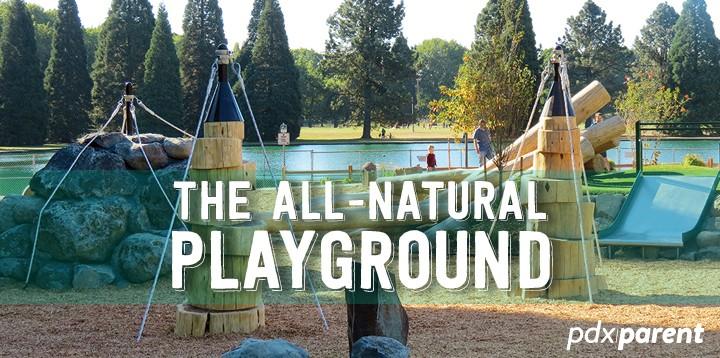Begone plastic and metal!
Natural materials are the next big thing in playgrounds, in PDX and beyond.
Close your eyes and think of your neighborhood playground. What comes to mind, most likely? Swings, a slide, the monkey bars, maybe a see-saw — beloved childhood staples, all.

But now a new generation of Portland-area playground visionaries is using age-old materials to reimagine what truly belongs at the park. That means out with the plastic and the metal and the manmade and in with sticks and stones, water and sand, logs and stumps.
Natural playgrounds, long popular in Europe, are popping up all over the United States and the Portland metro area is at the forefront of this back-to-nature movement, fueled in part by the enduring message in Richard Louv’s decade-old book, Last Child in the Woods: Saving Our Children From Nature-Deficit Disorder.
Louv pinpointed an uncomfortably familiar change in modern childhood: Kids are not playing outside as much as we did, or as did our parents before us. The reasons why are well-known: The lure of technology and the over-scheduling of structured, adult-led activities, parental fear of playing outdoors unsupervised (whether for natural risks or stranger danger) and restricted access to natural areas.
“This growing trend in play aims to harness some of nature’s allure and impact,” says Michelle Guthrie Mathis, a Portland-based landscape architect who focuses on natural environments, “while offering it in a contained, safer and more available setting.”
Playing outside doesn’t just give kids exercise. Research shows it helps kids with coordination and problem solving, cuts down on stress and frustration, and teaches them to risks, testing the limits of their abilities. Plus, kids who play outside learn to love nature — and they’re inheriting an Earth that will very much need their protection.
Getting Wet (and muddy!) in Westmoreland

The crown jewel of the city of Portland’s nature play areas in Westmoreland Park, opened last fall and featuring the restoration of Crystal Springs Creek. Running through the park on its way to merging with Johnson Creek, salmon are already spawning in Crystal Springs.
Westmoreland resident Bradley Heintz and his two sons used to stomp around Johnson Creek and Crystal Springs Creek in search of crawdads. But now that such activity is discouraged, in order to protect the creek and its wild inhabitants, he and his kids head to the nature play area instead.

The nature play area’s ability is especially good therapy for one of his sons, who has problems with sensory processing and wants to touch everything all the time. The variety of natural materials and loose parts of the new park “offer so many different sensory experiences,” says Heintz.
But Westmoreland Park is far from the only park in Portland to have a nature play area, or soon to boast one. The newly developed K’unamokwst Park in NE Portland’s Cully neighborhood will have nature play elements, such as a water and sand area with masonry mimicking geology of the Columbia River Gorge and a large sculpture of a Douglas Fir cone for climbing (a grand opening celebration is planned for May 16).

Another park planned for the Cully neighborhood will also incorporate nature play into its playground, such as a treehouse, a cave, a loose parts construction zone, and a climbing wall.
Portland has had a small nature play area for several years in a rather unassuming park in SW Portland. Atop the hill at Spring Garden Park, there is an area with a sand pit and rocks and logs for climbing, perfect for spontaneous visits for play and getting some energy out. The park will be redeveloped in the near future, with plans for a larger nature play area.
In NE Portland, nature play will also be a feature at the future Gateway Green park site, located on land in between I-205 and I-84 (the park will also offer trails for off-road bicycling) and in the redevelopment of Whitaker Ponds Nature Park.
Beyond city limits

Portland’s largest nature play area is not at a city park, however.
The 1.3 acre Outdoor Adventure exhibit opened at the Portland Children’s Museum in the spring of 2014. It offers a wide variety of play options, from a toddler-specific area and campsite for fort-building to a large climbing tree and hillside creek where kids can control the flow of water.
The Metro regional government, which oversees thousands of acres of natural areas across the region, is also a pioneer in nature play. The nature play area at Blue Lake Regional Park in Fairview replaced an old playground. It includes rocks and logs to climb on, loose parts for building, a sand pit, a log and rope balancing structure, and an osprey nest atop an upside down tree (planted in the middle of the play area as a centerpiece).

Metro’s next project will be several nature play options at Oxbow Regional Park in Gresham: a water and sand water experience geared toward younger children, and an off-trail nature play area for older kids and their parents that will get them exploring beyond the main access points of the park.
Rod Wojtanik, a landscape architect with Metro, said the agency is committed to nature play, and believes that it helps teach about finding their own boundaries, and personal comfort levels, with risks that are no more worrisome than those that go along with traditional playground structures and organized sports.

In and around Beaverton, the Tualatin Hills Park and Recreation District offers nature play at several sites: Cooper Mountain Nature Park, Camille Park, Pioneer Park, and Roger Tilbury Memorial Park. A fifth nature play area is THPRD’s most unique. At Hyland Forest Natural Area, an official off-trail nature play area invites kids to explore an acre-and-a-half area of forest and do what they please: build forts, climb trees, and dig in the ground. Signs mark off the play area around its perimeter, to prevent off-trail use.
“It’s good for kids to get outside and get dirty,” says Bruce Barbarasch, Superintendent of Natural Resources for THPRD. “We need to provide places for kids to play in nature, where it’s fun and safe.”

The park district is currently recruiting volunteers to conduct user surveys for their nature play areas to gain feedback about their use and impact on children’s views about nature, to inform the development of future nature play areas.
Plenty of other nature play opportunities are available at parks across the region (see map). With a grand opening celebration set for May 16, the new Nadaka Nature Park in Gresham will have a large nature play area, including a water and sand feature similar to Westmoreland Park.

Eugene and Bend have included nature play into some parks, and a new park in Medford will have a nature play area. Finally, a nationally-recognized nature play area can be found at Silver Falls State Park near Silverton. The North Canyon Nature Play Area, which opened in spring 2014, offers children a setting to pretend being various animals that call the state park home.
Organized as a quarter-mile loop of animal pods, kids can climb a tree, hang out in a cougar den, act like a bear, or construct a bird’s nest. The new nature play area allows them to go at their own pace across a much larger space than a trail path. The Oregon Parks and Recreation Department is now looking into putting nature play areas in more state parks, such as Tryon Creek State Park in Portland.
Next steps
While the United States is not as far along as some European countries and Australia, the Portland region is among several areas nationally leading the way in bringing nature back to play.
“The completion of the Westmoreland Park Nature Play Area,” says Ben Johnson, “is really at the beginning of a national groundswell for these types of play areas.”
One key benefit is that nature play areas can engage tweens, who may disdain traditional playgrounds. In off-trail play spaces, middle schoolers can try out independence while building forts and tromping through vegetation.
How much it costs to build and maintain a nature play area, versus a traditional playground, is still up for debate, parks planners say. The bottom line depends on how big the planned nature play area is, and what its various elements are. Sandra Burtzos, Portland Parks & Recreation’s project manager for Westmoreland Park, said it would have cost roughly the same amount to put a traditional playground into that space. But the park’s new incarnation has added value, she said, because it’s quickly become a destination playground for families from around the city, looking for a different kind of day at the park.
One thing is certain: kids are having fun and getting dirty. And more often than not, their grown-ups are too.
“Rather than sitting along the sidelines and watching their kids play, parents can be engaged by nature play areas, too,” says Bradley Heintz.
1. Westmoreland Park Nature Play Area, SE McLoughlin Blvd & SW Bybee Blvd, Portland
2. Spring Garden Park, 3332 SW Spring Garden St, Portland
3. Marshall Park, SW 18th Pl, Portland
4. K’unamokwst Park (to open spring 2015), NE 52nd Ave & NE Alberta St, Portland
5. Gateway Green (planned), NE Portland in between I-205 and I-84
6. Whitaker Ponds Nature Park (planned), 7040 NE 47th Ave, Portland
7. Blue Lake Regional Park, 20500 NE Marine Dr, Fairview
8. Cooper Mountain Nature Park, 18892 SW Kemmer Rd, Beaverton
9. Oxbow Regional Park (planned), 3010 SE Oxbow Pkwy, Gresham
10. Hyland Woods Natural Area, SW Sexton Mountain Dr, E of SW Murray Blvd, Beaverton
11. Camille Park, W end of SW Marjorie Ln, Beaverton
12. Pioneer Park, 14545 NW Pioneer Rd, Beaverton
13. Roger Tilbury Memorial Park, 965 NW 93rd Ave, Portland
14. Outdoor Adventure Portland Children’s Museum, 4015 SW Canyon Rd, Portland
15. Trillium Creek Park, 16803 SE Anderegg Pkwy, Damascus
16. Pioneer Park, SE 152nd Ave & SE Pioneer Dr, Clackamas
17. North Canyon Nature Play Area at Silver Falls State Park, 20024 Silver Falls Hwy SE, Sublimity
18. Orenco Woods Nature Park (planned), NW 225th Ave & NW Birch St, Hillsboro
19. Nadaka Nature Park (to open spring 2015), NE Pacific St, Portland
20. Dirksen Nature Park (planned), 11130 SW Tiedeman Ave, Tigard
21. Ibach Park, 10455 SW Ibach St, Tualatin
22. Jurgens Park, 17255 SW Jurgens Ave, Tualatin
23. Engleman Park, 29987 SW Montebello Dr, Wilsonville
24. Hawthorne Park, SE King Rd & SE 74th Ave, Southgate
25. Marshall Community Park, 1015 E McLoughlin, Vancouver
26. Jorgenson Woods Neighborhood Park, NW 3rd Ave & NW 72nd Circle, Vancouver
- The All-Natural Playground - September 11, 2016
- Native Nature - March 29, 2016





